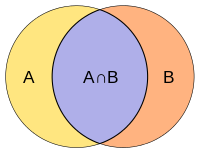This article includes a list of general references, but it lacks sufficient corresponding inline citations. (March 2011) |
Intersection over union as a similarity measure for object detection on images – an important task in computer vision.
The Jaccard index is a statistic used for gauging the similarity and diversity of sample sets. It is defined in general taking the ratio of two sizes (areas or volumes), the intersection size divided by the union size, also called intersection over union (IoU).
It was developed by Grove Karl Gilbert in 1884 as his ratio of verification (v)[1] and now is often called the critical success index in meteorology.[2] It was later developed independently by Paul Jaccard, originally giving the French name coefficient de communauté (community coefficient),[3][4] and independently formulated again by T. Tanimoto.[5] Thus, it is also called Tanimoto index or Tanimoto coefficient in some fields.
- ^ Murphy, Allan H. (1996). "The Finley Affair: A Signal Event in the History of Forecast Verification". Weather and Forecasting. 11 (1): 3. Bibcode:1996WtFor..11....3M. doi:10.1175/1520-0434(1996)011<0003:TFAASE>2.0.CO;2. ISSN 1520-0434. S2CID 54532560.
- ^ "Forecast Verification Glossary" (PDF). noaa.gov. Retrieved 21 May 2023.
- ^ Jaccard, Paul (1901). "Étude comparative de la distribution florale dans une portion des Alpes et des Jura". Bulletin de la Société vaudoise des sciences naturelles (in French). 37 (142): 547–579.
- ^ Jaccard, Paul (February 1912). "The Distribution of the Flora in the Alpine Zone.1". New Phytologist. 11 (2): 37–50. doi:10.1111/j.1469-8137.1912.tb05611.x. ISSN 0028-646X. S2CID 85574559.
- ^ Cite error: The named reference
:1was invoked but never defined (see the help page).




